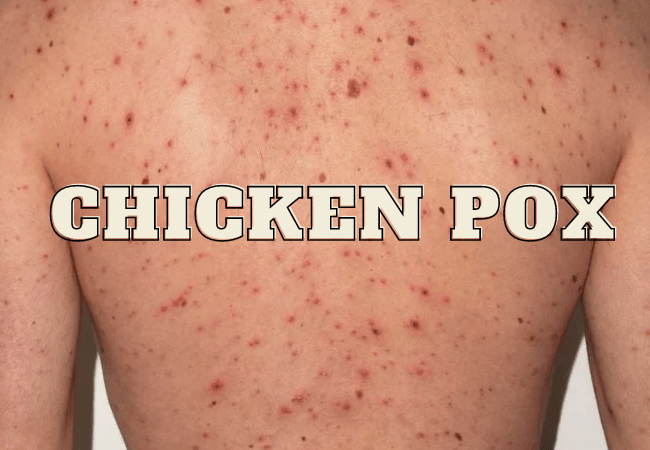Definition of Chickenpox Disease:
Chickenpox or varicella is an acute, highly infectious disease caused by varicella-zoster virus. It is characterized by vesicular rash that may be accompanied by fever and malaise. It is highly communicable and infectious disease caused by varicella virus, characterized by mild prodromal symptoms and a typical rash which passes through the stages of macule, papule, vesicle and crustation. Chickenpox is an acute and highly communicable disease caused by varicella-zoster (V-Z) virus.

Epidemiological Features of Chickenpox Disease:
1. Agent factors:
a) Agent: Varicella zoster virus.
b) Source of infection:
- Oropharyngeal secretion,
- Lesions of skin and mucosa, and
- Rarely A patient with herpes zoster.
c) Infectivity: 1-2 days before appearance of rash and 4-5 days thereafter.
d) Secondary attack rate: The disease is highly contagious, so secondary attack rate in household contacts approximately 90%.
2. Host factors:
a) Age: Primarily among children under 10 years. Few may escape until adulthood.
b) Immunity: One attack gives life ling immunity.
c) Pregnancy: Presents a risk for the foetus and the neonate.
3. Environmental factors:
Overcrowding favors its transmission.
4. Transmission:
Person to person by droplet infection and by droplet nuclei. Vertical transmission is possible and can infect the foetus.
5. Incubation period:
Usually 14 to 16 days. The range may vary from 7 to 21 days.
Clinical Features or Sign and Symptoms of Chickenpox:
Clinical spectrum of chicken pox may vary from a mild illness and only a few scattered lessons to febrile illness and widespread rash.
1. Pre-eruptive stage:
- Mild to moderate fever,
- Pain in the back,
- Shivering,
- Malaise.
2. Eruptive stage:
In children the rash is often first sign.
a) Distribution:
- Centripetal,
- Rashes are symmetrical,
- First appears in trunk (abundant),
- They come to face, arms, and where it is less abundant,
- Mucosal surface usually affected,
- Axilla may be affected,
- Palms and soles are not usually affected.
b) Rapid Evolution:
- Stages – Macule, Papule, Vesicle, Scab.
- Vesicles are filled and fluid is and looking like dew drops on the skin.
- Vesicles may form crust without going through pustular stage.
c) Pleomorphisnm:
All the stages of the rash (papule, vesicle, crust) may be seen simultaneously, at one time in the same area.
d) Fever:
Fever does net run high but shows exacerbations and each fresh crop of eruption.
Complications of Chicken Pox Disease:
it includes the following:
1. Viral effects:
- Hemorrhage (Varicella hacmorrhagica),
- Pneumonia,
- Encephalitis,
- Acute cerebral ataxia,
- Myocarditis,
- Reye’s syndrome (Acute encephalopathy + fatty degeneration of the liver),
- Oncogencity,
- Glomerulonephritis.
2. Secondary bacterial infection:
- Skin,
- Septicemia,
- Osteo-myelitis/septic arthritis.
3. Intra-uterine infection:
a) Foetal wastage.
b) Congenital birth defects:
- Cutaneous scars
- Atrophied limbs
- Micro-cephaly
- Low birth weight.
Prevention of Chickenpox Disease:
Chickenpox can be prevented by the below ways:
1. Varicella-Zoster Immunoglobulin (VZIG):
Varicella-Zoster Immunoglobulin (VZIG) given within 72 hours of exposure for prevention of chickenpox in exposed susceptible individuals particularly in immuno-suppressed persons.
2. Vaccine:
Alive attenuated varicella virus vaccine is safe and currently recommended for children between 12- 18 months of age who have not had chickenpox.
Control:
- Immunization of high risk groups,
- Notification (To exclude small pox),
- Isolation of cases for about 6 days after onset of rash, Antiviral therapy.
More questions related to this article:
- What do you mean by chickenpox?
- Define chickenpox.
- What is chickenpox?
- What are the epidemiological features of chicken pox?
- Mention the epidemiological features of chicken pox.
- Enumerate the clinical features of chickenpox.
- What are the sign and symptoms of chickenpox?
- What are the complications of chickenpox?
- How can chickenpox be prevented?
- Write down the preventive measure of chicken pox?
- How to prevent chickenpox?
- How chickenpox can be prevented?

Maria Khatun Mona is a Founder and Editor of Nursing Exercise Blog. She is a Nursing and Midwifery Expert. Currently she is working as a Registered Nurse at Evercare Hospital, Dhaka, Bangladesh. She has great passion in writing different articles on Nursing and Midwifery. Mail her at “maria.mona023@gmail.com”
